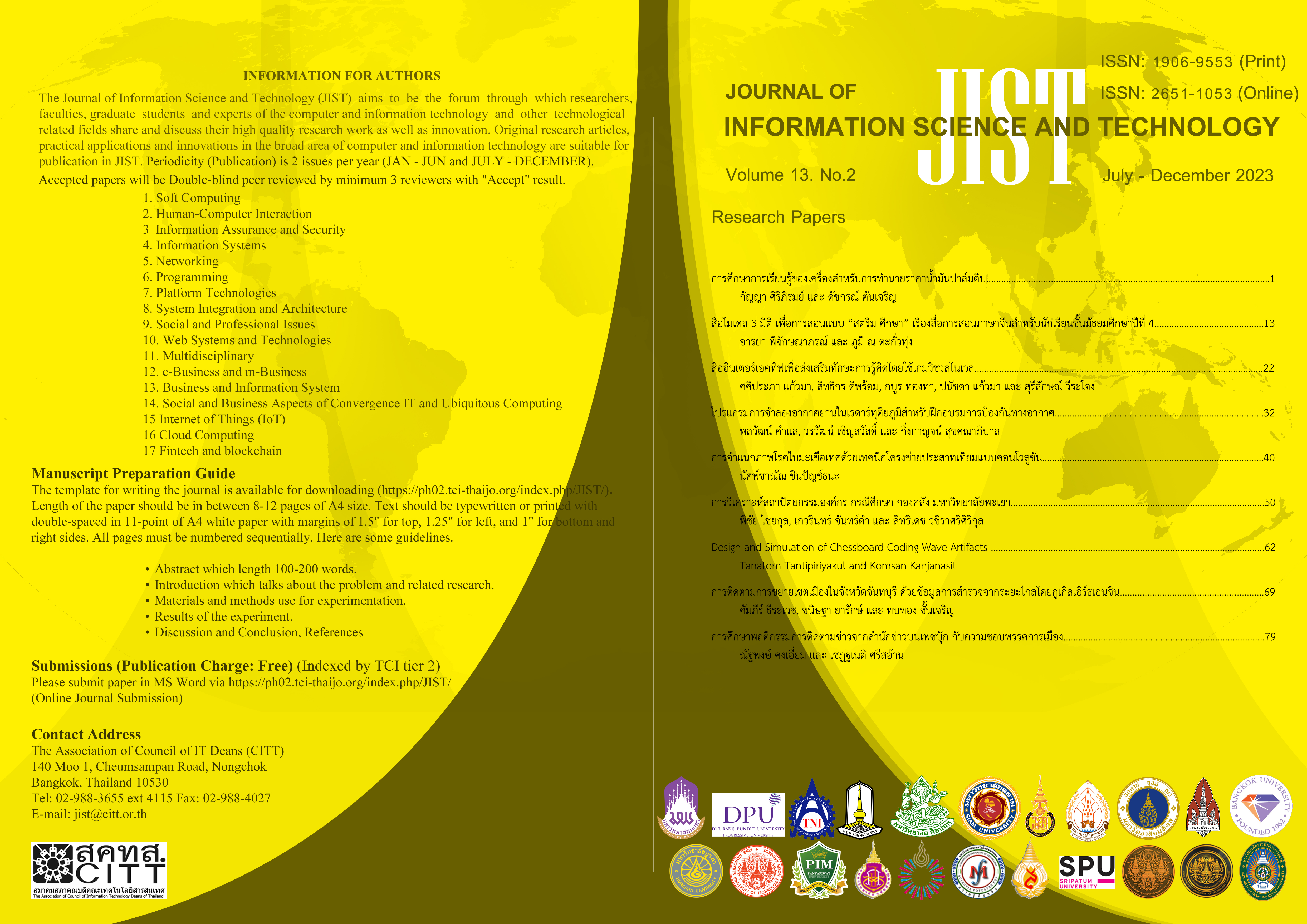3D modeling media in STEAM education on Chinese instructional for secondary student at 10th
Main Article Content
Abstract
In this paper, we present the result of the development of learning technique for using 3D model with STEAM Education for learn Chinese. Learners given more on practice and develop skill that engage curiosity and self-learning. We developed a learning system that integration subsistence wish suit to the age and student development wish will fortify student thought process, questioning, searching for reasons and truly understanding answers. By a combination of digital teaching medias and 3D paper crafting for teaching “Telling Time in Modern Chinese” and “Ancient Chinese Language”. It is evaluated with 40 high school students and collect student’s attitude in Chinese language learning. The results showed that the attitude has 0.67-point increase or 4 percentages.
Article Details
This work is licensed under a Creative Commons Attribution-NonCommercial-NoDerivatives 4.0 International License.
I/we certify that I/we have participated sufficiently in the intellectual content, conception and design of this work or the analysis and interpretation of the data (when applicable), as well as the writing of the manuscript, to take public responsibility for it and have agreed to have my/our name listed as a contributor. I/we believe the manuscript represents valid work. Neither this manuscript nor one with substantially similar content under my/our authorship has been published or is being considered for publication elsewhere, except as described in the covering letter. I/we certify that all the data collected during the study is presented in this manuscript and no data from the study has been or will be published separately. I/we attest that, if requested by the editors, I/we will provide the data/information or will cooperate fully in obtaining and providing the data/information on which the manuscript is based, for examination by the editors or their assignees. Financial interests, direct or indirect, that exist or may be perceived to exist for individual contributors in connection with the content of this paper have been disclosed in the cover letter. Sources of outside support of the project are named in the cover letter.
I/We hereby transfer(s), assign(s), or otherwise convey(s) all copyright ownership, including any and all rights incidental thereto, exclusively to the Journal, in the event that such work is published by the Journal. The Journal shall own the work, including 1) copyright; 2) the right to grant permission to republish the article in whole or in part, with or without fee; 3) the right to produce preprints or reprints and translate into languages other than English for sale or free distribution; and 4) the right to republish the work in a collection of articles in any other mechanical or electronic format.
We give the rights to the corresponding author to make necessary changes as per the request of the journal, do the rest of the correspondence on our behalf and he/she will act as the guarantor for the manuscript on our behalf.
All persons who have made substantial contributions to the work reported in the manuscript, but who are not contributors, are named in the Acknowledgment and have given me/us their written permission to be named. If I/we do not include an Acknowledgment that means I/we have not received substantial contributions from non-contributors and no contributor has been omitted.
References
สุภัค โอฬาพิริยกุล, “STEAM EDUCATION:นวัตกรรมการศึกษาบูรณาการสู่การจัดการเรียนรู้”,วารสารวิจัยและพัฒนาหลักสูตร โรงเรียนสาธิมหาวิทยาลัยศรีนครินทรวิโรฒ ประสานมิตร(ฝ่ายมัธยม),หน้า1,ปีที่ 9 ฉบับที่ 1 มกราคม-มิถุนายน 2562.
วรรณิษา ไวยฉายี, “การจัดการเรียนการสอนภาษาจีนในสถาณการณ์ปัจจุบัน: มุมมองของผู้เรียนต่อการพัฒนาสถาบันสอนภาษา”,วารสานบัณฑิตศึกษา มหาวิทยาลัยราชภัฏวไลยอลงกรณ์ ในพระบรมราชูปถัมภ์,หน้าที่ 154,ปีที่ 16 ฉบับที่ มกราคม-เมษายน 2565,
Y. Li and A. H. Schoenfeld, “Problematizing teaching and learning mathematics as ‘given’ in STEM Education - International Journal of STEM Education,” SpringerLink, 19-Dec-2019. [Online]. Available: https://link.springer.com/article/10.1186/s40594-019-0197-9. [Accessed: 12-Feb-2023].
บุญยนุช สิทธาจารย์, “การพัฒนาชุดการสอนศิลปะตามแนวคิดสะตีมศึกษาเพื่อส่งเสริมกระบวนการสร้างสรรค์สำหนับนักเรียนชั้นประถามศึกษาปีที่ 5”,วิทยานิพนธ์หลักสูตรปริญญาครุศาสตรมหาบัณฑิต, 2560.
W. WU, W. Chalermvongsavej, “Factors Affecting Students’ Motivation in Chinese Language Learning at Private Bilingual School A,” Silpakorn Educational Research Journal : Vol. 14 No. 1, 29-June-2022.
[Online]. Available: https://so05.tci-thaijo.org/index.php/suedureasearchjournal/article/view/256690 [Accessed: 19-May-2023].
“พับกระดาษ ฝึกสมาธิ สงบสติอารมณ์,” มูลนิธิหัวใจแห่งประเทศไทยในพระบรมราชูปถัมภ์ https://www.thaiheartfound.org/Article/Detail/140326?fbclid=IwAR2uggeoPWS0UOxU0TX68Yr9GOHDnUrP1h3D3_yUfYHB0T9WButjM8JP6kU [Accessed: 19-May-2023].
B. Natalija, Z. Lavicza and K. Fenyvesi, “Developing primary school students' formal geometric definitions knowledge by connecting origami and technology,” International Electronic Journal of Mathematics Education, 02-Nov-2019. [Online]. Available: https://www.iejme.com/article/developing-primary-school-students-formal-geometric-definitions-knowledge-by-connecting-origami-and-6266. [Accessed: 12-Feb-2023].
J. Guy, J. Muzaffar, C. Coulson, “Teaching middle ear anatomy using a novel three-dimensional papercraft model - European Archives of Oto-Rhino-Laryngology,” SpringerLink, 24-Sept-2020. [Online]. Available:
https://link.springer.com/article/10.1007/s00405-020-06350-8 [Accessed: 19-May-2023].



